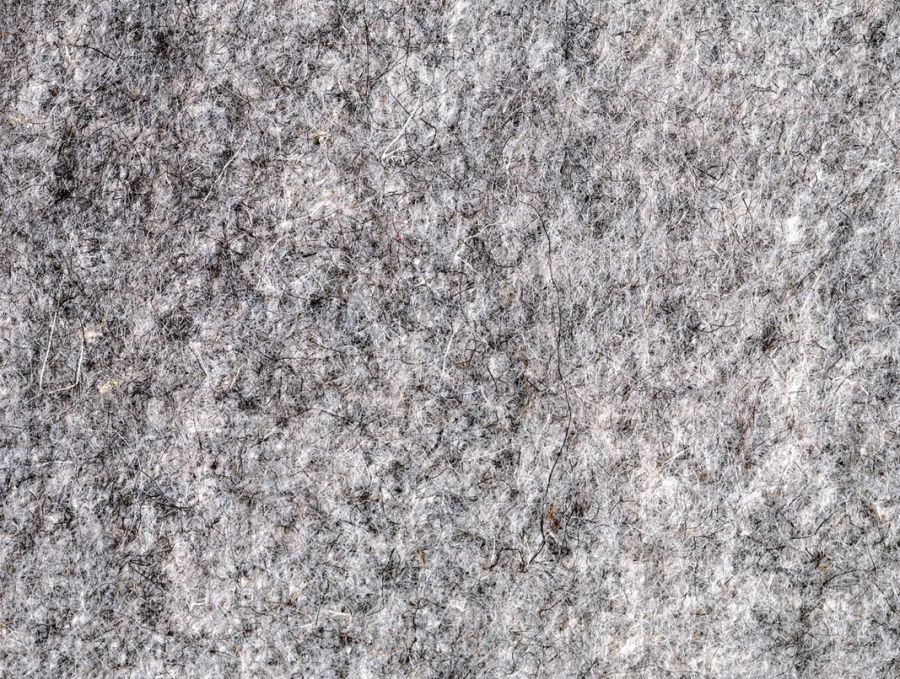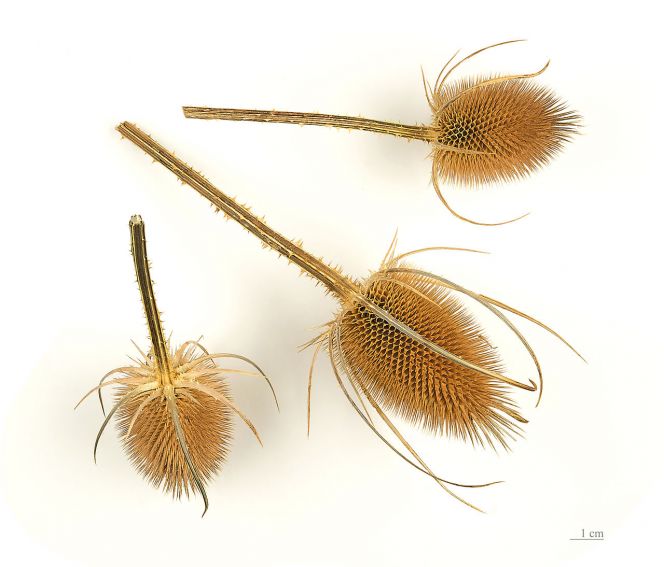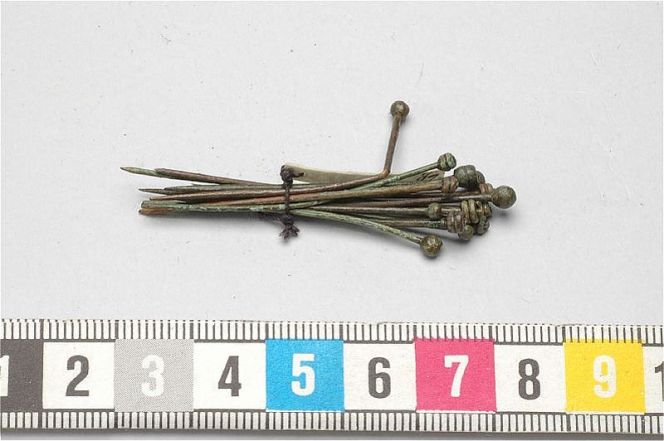ikfoundation.org
Promoting Natural & Cultural History



ESSAYS |
THE TEXTILE PRODUCTION
– a Medieval Town
A rich selection of excavated textile tools from Malmö gives a good understanding of textile production in the Medieval period. This is in the context of local spinning, weaving, or plaiting, studied from spindle whorls of various materials, loom weights, and more implements. Other unearthed finds are pins, needles, needle cases, thimbles and linen smoothers – needed for the sewing and taking care of locally-made as well as imported fabrics. This third historical essay, which is related to the medieval development of the coastal town Malmö, today in southernmost Sweden, aims to describe the former inhabitants’ daily lives through these preserved textile tools. A selection of five images will assist and be used as comparable sources.
![These five bone tools [Tinbl-bein] are hollow, making it possible to create a type of cord, like a “knitted rounded string”. A cord of this sort was used as a practical or decorative addition to the clothing and possibly also for details in textile interiors. These artefacts have all been excavated from former Medieval houses in the Malmö area. Judging by the beautifully carved decorations, an item like this is believed to have been presented as a gift to the bride-to-be (Courtesy of: Malmö Museum).](https://www.ikfoundation.org/uploads/image/1-medieval-3-jpg-900x486.jpg) These five bone tools [Tinbl-bein] are hollow, making it possible to create a type of cord, like a “knitted rounded string”. A cord of this sort was used as a practical or decorative addition to the clothing and possibly also for details in textile interiors. These artefacts have all been excavated from former Medieval houses in the Malmö area. Judging by the beautifully carved decorations, an item like this is believed to have been presented as a gift to the bride-to-be (Courtesy of: Malmö Museum).
These five bone tools [Tinbl-bein] are hollow, making it possible to create a type of cord, like a “knitted rounded string”. A cord of this sort was used as a practical or decorative addition to the clothing and possibly also for details in textile interiors. These artefacts have all been excavated from former Medieval houses in the Malmö area. Judging by the beautifully carved decorations, an item like this is believed to have been presented as a gift to the bride-to-be (Courtesy of: Malmö Museum).Even if the spinning wheel was already known in the 14th century on the continent, the spindle was still solely used for spinning threads of wool or linen for several centuries in the Nordic area. Traces from the intense spinning activity can be studied via 48 spindle whorls found in Malmö and the closely situated area. These were foremost made of bone, unglazed or glazed pottery and in rare examples made from an imported stoneware quality. When the raw material of wool or flax was spun, the yarn could be twined if one needed a stronger thread; this was particularly important for the warp.
During the first three hundred years of the Medieval period, the use of the warp-weighted loom dominated the local production, and a substantial selection of excavated loom-weights is proof of the weaving of such fabrics in Malmö. Four examples from the town itself. In addition to forty fragmented pieces and one intact loom-weight located in the closely situated village of Oxie. Research by historian Eva Andersson also shows that these loom weights were heavier than many other excavated examples in the Nordic area, which can possibly indicate that linen fabrics were produced on these looms. This theory is further strengthened as linen smoothers of stone were unearthed close to these loom weights. Among other fragmented evidence for weaving in the first half of the Medieval period in Malmö (the district of C. Mortensen, 6525:3) is also a wooden sword-like tool used for pressing the weft upwards during the weaving.
![This detailed depiction of a weaver from Nürnberg [Germany] ca 1425 is a good comparison with the horizontal looms, a type also used by weavers in Malmö during the 14th and 15th centuries (Courtesy of: Wikimedia Commons).](https://www.ikfoundation.org/uploads/image/2-medieval-3-weaver-e28093-nc3bcrnberg-c-1425-664x982.jpg) This detailed depiction of a weaver from Nürnberg [Germany] ca 1425 is a good comparison with the horizontal looms, a type also used by weavers in Malmö during the 14th and 15th centuries (Courtesy of: Wikimedia Commons).
This detailed depiction of a weaver from Nürnberg [Germany] ca 1425 is a good comparison with the horizontal looms, a type also used by weavers in Malmö during the 14th and 15th centuries (Courtesy of: Wikimedia Commons).The great advantage of the horizontal loom was that the weaver’s feet shifted the shed with the help of the treadles while the hands shuttled the weft from one side to another. A much more effective and quicker way to produce cloth. At the same time as, more complicated weaving techniques had more significant potential and possibilities to develop into new variations, depending on the amount of heddles, treadles and how these were combined. Even research of contemporary handwritten documents gives evidence that this type of horizontal loom existed in the second half of the Medieval period in the Nordic area. However, to find looms or parts of these are very rare, and in Malmö, as in many other locations, there are no traces of these looms. First and foremost, these looms were made of wood, a material having poor chances of survival in most types of soil. Additionally, it is very likely that old or damaged looms, no longer in use, were seen as valuable firewood. It must also be emphasised that loom-weights have not been present in any excavations related to the 14th and 15th centuries in the town, strengthening the view that the warp-weighted loom at this time was replaced by the horizontal model.
 Woollen fabric, reproduced from a historical original in a 3/1 twill; the cloth has also gone through a fulling process to make it warmer, thicker and finished off with napping on one side. This type of twill, woven on three shafts, is considered to have been produced in the second half of the Medieval period, while the technique was unsuitable for an upright loom. However, early textile finds of this kind exist from the Nordic area, but are believed to have been imported from the Continent where the horizontal loom was known prior to this time. In Malmö, this type of woollen twills were possibly firstly produced in the 14th century. (Woven reconstruction: Grethe Mårtensson). Photo: The IK Foundation, London.
Woollen fabric, reproduced from a historical original in a 3/1 twill; the cloth has also gone through a fulling process to make it warmer, thicker and finished off with napping on one side. This type of twill, woven on three shafts, is considered to have been produced in the second half of the Medieval period, while the technique was unsuitable for an upright loom. However, early textile finds of this kind exist from the Nordic area, but are believed to have been imported from the Continent where the horizontal loom was known prior to this time. In Malmö, this type of woollen twills were possibly firstly produced in the 14th century. (Woven reconstruction: Grethe Mårtensson). Photo: The IK Foundation, London. Fruit at maturity, of Fuller’s teasel. Several plants of the Dipsacus genus have a long and important history in the fulling process of woollen cloth. The aid of this plant was probably in use during the Medieval period in Malmö – as in many other places – to make the coarse fabrics warm and suitable for the cold climate (Courtesy of: Wikimedia Commons).
Fruit at maturity, of Fuller’s teasel. Several plants of the Dipsacus genus have a long and important history in the fulling process of woollen cloth. The aid of this plant was probably in use during the Medieval period in Malmö – as in many other places – to make the coarse fabrics warm and suitable for the cold climate (Courtesy of: Wikimedia Commons).On many of the preserved textile fragments, traces of stitching are visible. Most common are to see needle holes and sometimes pieces of sewing thread in connection to these. However, from the district of St Gertrud, more advanced work can be studied on two delicate greyish-brown silk fabrics (4560 11.4a-b). To strengthen and decorate, the seams have been made with the help of bias strips and back- and hemstitching. This combination of seams was common during the Medieval period in various European locations, among other places on Anglo-Scandinavian garments/fragments excavated in York. In the case of the Malmö finds as well as in other regions, the fabric commonly matched the used sewing thread – silk on silk, wool on woollen cloth and linen on linen qualities.
 Pins became necessary when tailors and seamstresses began to cut cloth during the second half of the 14th century and needed a tool to hold the various pieces of material in place during sewing. Pins have been found in excavations from Malmö (8 examples), but is also a common tool found in many Nordic areas. These 16 depicted pins are a good comparable source, used at Vadstena Nunnery during the Medieval period (Courtesy of: The Swedish History Museum, Stockholm).
Pins became necessary when tailors and seamstresses began to cut cloth during the second half of the 14th century and needed a tool to hold the various pieces of material in place during sewing. Pins have been found in excavations from Malmö (8 examples), but is also a common tool found in many Nordic areas. These 16 depicted pins are a good comparable source, used at Vadstena Nunnery during the Medieval period (Courtesy of: The Swedish History Museum, Stockholm).Approximately 100 needles have been unearthed from Medieval settlements in Malmö, most often made of bone. The reasons for the popularity of bone are believed to have origins in the fact that the material was easy to access and cheap, since long before this period, it was traditionally used for needles and was not corroding. Most needles have a sharp point; twelve examples of this tool have been found in a concentrated area in nearby Oxie. A usage for these needles can have been to sew linen sails; as mentioned above, linen cloth was probably woven in warp-weighted looms here. Similar finds of eight to nine-centimetre-long bone needles have also been unearthed in Malmö, together with two more ornate tools (6724:32&7). The use for these could have been needle-binding due to a larger eye.
Twenty bronze- and seven iron needles, thinner and shorter than the bone models, have also been found in various excavations in Malmö and its nearby area. These were often formed with smaller eyes, making the needles ideal for sewing fine seams in clothing or for decorative embroideries. Cases for needles have additionally been excavated on five occasions, one of the most beautiful in the area of Söderport (6724:38). This needle case is 5,7 cm long and has a diameter of 1,2 cm, a small polished item with a carved chequered pattern and a lid.
Medieval thimbles are very similar in appearance to modern models; the materials include bronze, brass, copper or, more rarely, silver. Thimbles have been excavated from various settlements in Malmö to a total of 35 numbers. Noticeable is that 14 of these (the majority of copper) were found in the area of Tranan; one likely reason for this is that tailors worked in this part of the town. Linen smoothers of stone were another tool used by the tailors to smooth the hems during their work. This tool was also an essential tool in the home for getting linen garments and maybe wool and silk as well smooth after washing. Seven tools of this kind have been found in Malmö and closely situated to Oxie, in the shape of a roundish, relatively flat stone with a diameter of seven to ten centimetres. However, the linen smoothers can be traced back to the Iron Age and were in use through the whole Medieval period and even up to the early 19th century, when this tool was still common in farming families to assist the laundress in getting linen garments perfectly smooth.
Notice: The numbering within brackets is Malmö Museum’s catalogue numbers. For a full Bibliography and a complete list of excavated textile fragments, tools, etc, please see the Swedish article by Viveka Hansen, 2001.
Sources:
- Anonymous, Hausbuch der Mendelschen Zwölfbrüderstiftung, Band 1. Nürnberg 1426–1549.
- Hansen, Viveka, ‘Förhistoriska och Medeltida Textilier i Malmö’, Elbogen pp. 73-144. 2001 (pp. 116-22).
- The Swedish History Museum, Stockholm (Digital sources: Medieval pins).
Essays
The iTEXTILIS is a division of The IK Workshop Society - a global and unique forum for all those interested in Natural & Cultural History from a Textile Perspective.
Open Access essays - under a Creative Commons license and free for everyone to read - by Textile historian Viveka Hansen aiming to combine her current research and printed monographs with previous projects dating back to the late 1980s. Some essays also include unique archive material originally published in other languages, made available for the first time in English, opening up historical studies previously little known outside the north European countries. Together with other branches of her work; considering textile trade, material culture, cloth manufacturing, fashion, natural dyeing and the fascinating world of early travelling naturalists – like the "Linnaean network" – from a Global history perspective.
For regular updates, and to make full use of iTEXTILIS' possibilities, we recommend fellowship by subscribing to our monthly newsletter iMESSENGER.
been copied to your clipboard




– a truly European organisation since 1988
Legal issues | Forget me | and much more...
It is free to use the information/knowledge in The IK Workshop Society so long as you follow a few rules.
 LEARN MORE
LEARN MORE








